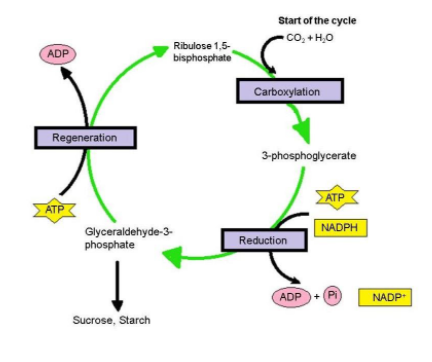
Define carbon fixation in plants. What was the contribution of Melvin Calvin? Describe the three phases of Calvin cycle.
Answer
473.1k+ views
Hint:This is the process by which plants convert light energy into chemical energy. Utilization of $CO_2$ takes place during this process.
Complete Answer:
Autotrophic organisms have the capability to transform atmospheric $CO_2$ to a reduced state i.e. carbohydrate and, this process is known as carbon fixation or carbon assimilation. All the photosynthetic eukaryotes, from the most primitive alga to the most advanced angiosperm, reduce $CO_2$ to carbohydrate through the same basic mechanism.
Contribution of Melvin Calvin: The complete biosynthetic pathway of photosynthetic carbon reduction cycle was for the first time elucidated by Melvin Calvin in and his colleagues in the 1950s that is why it is called the Calvin cycle. He inserted the radioactively labelled carbon (14C) into photosynthetic algae and analysed the pathway of carbon fixation in the plant by the method of two-dimensional paper chromatography. For this work he was awarded the Nobel Prize in 1961. He discovered that the first stable product formed during the process of carbon fixation is a 3-carbon organic acid, namely, 3-phosphoglyceric acid (PGA). Thus, it is also called the C3 cycle.
Three phases of Calvin cycle: The Calvin cycle proceeds in three stages –
1. Carboxylation: In this stage $CO_2$ and water from the environment enzymatically combine with a 5-carbon compound, Ribulose-1, 5-bisphosphate (RuBP), and generates two molecules of a 3-carbon intermediate, 3- phosphoglycerate which is the first stable compound of the Calvin cycle.
2. Reduction: In this stage, 3-phosphoglycerate is reduced to glyceraldehyde-3-phosphate (a carbohydrate) by the use of ATP and NADPH which are produced during light reaction.
3. Regeneration: The cycle is completed by the regeneration of ribulose-1,5-bisphosphate from glyceraldehyde-3-phosphate. Ribulose-1, 5-bisphosphate is the $CO_2$ acceptor.

Note:The $C_4$ photosynthetic carbon assimilation cycle and the photorespiratory carbon oxidation cycle ($C_2$ cycle) are either supplementary to or dependent on the basic $C_3$ cycle.
Complete Answer:
Autotrophic organisms have the capability to transform atmospheric $CO_2$ to a reduced state i.e. carbohydrate and, this process is known as carbon fixation or carbon assimilation. All the photosynthetic eukaryotes, from the most primitive alga to the most advanced angiosperm, reduce $CO_2$ to carbohydrate through the same basic mechanism.
Contribution of Melvin Calvin: The complete biosynthetic pathway of photosynthetic carbon reduction cycle was for the first time elucidated by Melvin Calvin in and his colleagues in the 1950s that is why it is called the Calvin cycle. He inserted the radioactively labelled carbon (14C) into photosynthetic algae and analysed the pathway of carbon fixation in the plant by the method of two-dimensional paper chromatography. For this work he was awarded the Nobel Prize in 1961. He discovered that the first stable product formed during the process of carbon fixation is a 3-carbon organic acid, namely, 3-phosphoglyceric acid (PGA). Thus, it is also called the C3 cycle.
Three phases of Calvin cycle: The Calvin cycle proceeds in three stages –
1. Carboxylation: In this stage $CO_2$ and water from the environment enzymatically combine with a 5-carbon compound, Ribulose-1, 5-bisphosphate (RuBP), and generates two molecules of a 3-carbon intermediate, 3- phosphoglycerate which is the first stable compound of the Calvin cycle.
2. Reduction: In this stage, 3-phosphoglycerate is reduced to glyceraldehyde-3-phosphate (a carbohydrate) by the use of ATP and NADPH which are produced during light reaction.
3. Regeneration: The cycle is completed by the regeneration of ribulose-1,5-bisphosphate from glyceraldehyde-3-phosphate. Ribulose-1, 5-bisphosphate is the $CO_2$ acceptor.

Note:The $C_4$ photosynthetic carbon assimilation cycle and the photorespiratory carbon oxidation cycle ($C_2$ cycle) are either supplementary to or dependent on the basic $C_3$ cycle.
Recently Updated Pages
Glucose when reduced with HI and red Phosphorus gives class 11 chemistry CBSE

The highest possible oxidation states of Uranium and class 11 chemistry CBSE

Find the value of x if the mode of the following data class 11 maths CBSE

Which of the following can be used in the Friedel Crafts class 11 chemistry CBSE

A sphere of mass 40 kg is attracted by a second sphere class 11 physics CBSE

Statement I Reactivity of aluminium decreases when class 11 chemistry CBSE

Trending doubts
10 examples of friction in our daily life

The correct order of melting point of 14th group elements class 11 chemistry CBSE

Difference Between Prokaryotic Cells and Eukaryotic Cells

One Metric ton is equal to kg A 10000 B 1000 C 100 class 11 physics CBSE

State and prove Bernoullis theorem class 11 physics CBSE

What organs are located on the left side of your body class 11 biology CBSE




